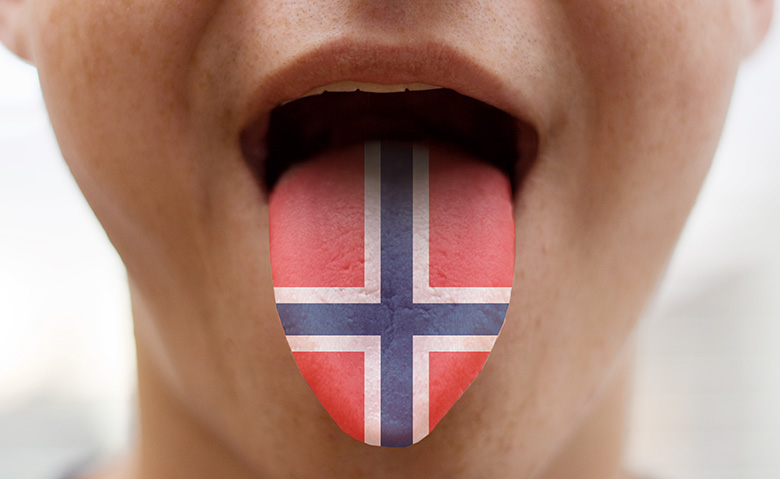
Moving a word to the beginning of a sentence is a useful trick to draw attention to the most important topic you want to relay. The researchers of a new study have found that the Scandinavian languages are unique in their use of this technique.
Linguist Dave Kush at NTNU’s Department of Language and Literature has been studying a phenomenon in which Norwegian, Swedish and Danish stand out.
Read more: How to Learn Norwegian
This language peculiarity has to do with the order of words, or the syntax. The basic point of the study is to better understand the grammatical building blocks in our brain.
Most important first
Moving the most important word to the beginning of a sentence is called topicalization. The first word acts as a “heading” for the rest of the sentence.
“Other languages also use topicalization, but the Scandinavians have developed topicalization into an art. The keyword can be retrieved from a relative clause and placed at beginning of the sentence, even when the context is a distance away. The connection – the interpretation of the first word – comes later in the sentence,” says Kush.
Sometimes topicalization works in both Norwegian and English, for example in the phrase “Han har ikke spist den kaka,” starting with the subject “He.” We can make the cake (object) the main point by moving the word to the beginning: “Den kaka har han ikke spist.”
Read more: Learn fluent Norwegian in six months
You can do exactly the same thing in English: “He hasn’t eaten that cake” can be switched to “That cake, he hasn’t eaten,” to indicate that exactly that one cake was not eaten.

Only in Scandinavian languages
But most of the time this only works in the Scandinavian languages. The phrase “Kaker lurer han på om Kari lager” (literally: Cakes wonders he if Kari is making.) works just fine in Norwegian.
We also understand what is meant when the question word is moved first: “Hva lurer han på om Kari lager?” (literally: What is he wondering if Kari is making?)
For Norwegians it also makes sense to say something like this: “Bakdøren blir han nervøs om de lar stå ulåst” (literally: The back door he is nervous whether they leave unlocked).
Read more: The Languages of Norway
“None of these sentences is viable in English. They would be perceived as wrong, and perhaps even incomprehensible,” says Kush.
And not just in English. Kush and his colleagues have investigated the research that has been done on a variety of languages, including Japanese, Italian and Arabic. Their findings indicate that the Scandinavian languages stand alone in being able to use topicalization so flexibly.
Icelandic does not have this language feature either, so this “invention” probably evolved after Old Norse fell out of use in Norway.
Flexible but not unrestricted word order
Norwegian speakers can move the object, question words and almost any sentence element to the front of the sentence and still understand the meaning. This works even if there is a great distance between the first word and what comes later in the sentence to give us the context for the meaning.

“But we can’t move the words around any which way. In a lot of cases, it works, but in others it doesn’t at all,” Kush says.
Read more: Learn Norwegian with Duolingo
If we put a question word first in the sentence: “Han blir nervøs om Sigrid baker boller” (literally: He gets nervous if Sigrid bakes buns), it’s too much even for Scandinavians. The phrase ” Hva blir han nervøs om Sigrid lager?” (literally: What does he get nervous if Sigrid bakes?) is not accepted as passable Norwegian. The sentence doesn’t work.
Unwritten rules
No written grammatical rules exist for which parts of speech or sentences can be moved and when. The researchers figure out what is possible or not by testing sentences on a variety of subjects. Although young and old choose different words, Kush did not find any difference between the generations in how they construct the sentences.
“Is it advantageous to be able to emphasize a word through moving it?”
“I don’t have an opinion on that. Why this language feature developed, we don’t know. Maybe it just happened by chance,” Kush says.
“Can this be perceived as the Scandinavian languages being under pressure and that their word order lacks organization?”
“No, all languages have built-in, complicated rules that determine what’s possible and what isn’t, particularly Norwegian,” he says.
Published internationally
In linguistics, it has been common to assume that universal boundaries exist for changing word order. But that is not the case.
Already in the 1980s it was reported that the Scandinavian languages allow radical changes in word order far more often than other languages do.
“The ‘invention’ probably happened after Old Norse fell out of use in Norway.”
Kush has confirmed that this is the case through scientific experiments with representative samples of people and has identified what people perceive as acceptable Norwegian – and what they don’t.
NTNU colleague Terje Lohndal and Jonathan Sprouse at the University of Connecticut collaborated with Kush to publish an article on Scandinavian topicalization in the autumn issue of Language, a leading journal of linguistic research.
To find out more about this Scandinavian language peculiarity, Kush and his colleagues plan to study how children learn which sentences are allowable and which are not. Researchers will use machine learning to simulate the children’s learning on computers.
This article was written by Svein Inge Meland for Gemini. It has been republished here with kind permission.


This phenomenon is inherent in many Australian Aboriginal Languages. Though many Languages have rules which govern word order, Aboriginal Languages generally have a subject/object/verb word order as opposed to the English subject/verb/object word order, many operate as ‘free order’ languages, where it is usual to put the most important piece of information first and the word order follows in diminishing order of importance.
The following sentence can be written six different ways by changing the word order which puts the focus on my toe, the rock or having kicked against the rock with my toe. Two examples only are given.
(e.g. burrami-dhi walang birganyba-yi [toe-my rock kick against-did] with emphasis on my toe, less so on the rock or that I kicked it.)
Sugests that I have really hurt my toe.
Walang-ga burrami-dhi birganyba-yi [rock-on toe-my kick against-did] emphasis on the rock, less on my toe or kicking it.
Suggests either I mistakenly kicked the rock or that the rock had caused a problem before.